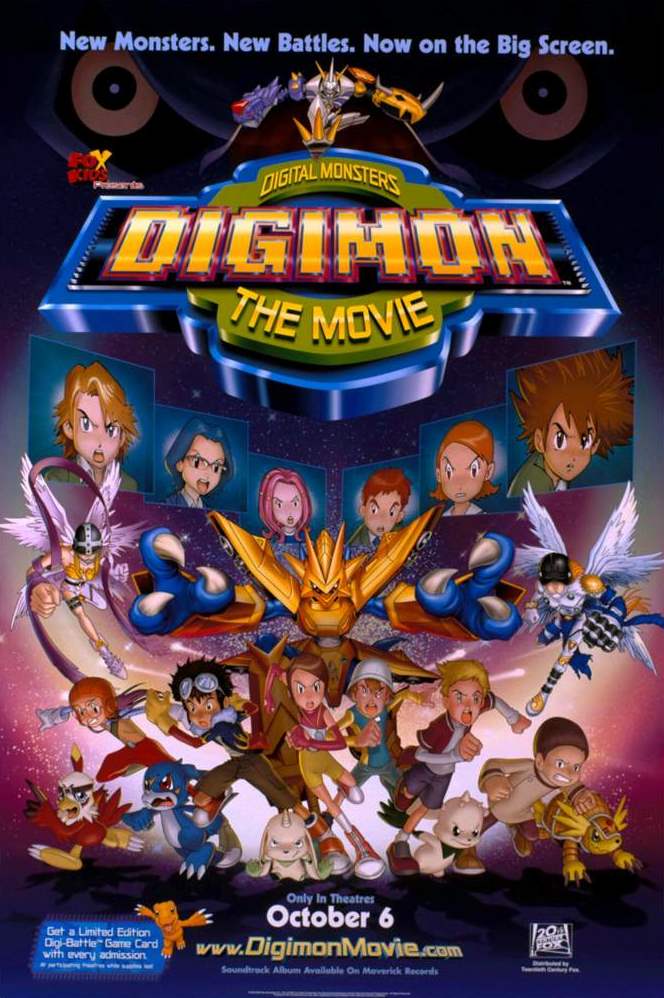aka Digital Monsters – Digimon: The Movie
Japan. 2000.
Crew
Directors – Mamoru Hosoda & Shigeyasu Yamauchi, Screenplay – Reiko Yoshida, English Language Adaptation – Bob Buccholz & Jeff Nimoy, Producer – Hiromi Seiki, English Language Version Produced by Terri-Lei O’Malley, Music – Udi Harpaz & Amotz Plessner, Animation Directors – Masahiro Aizawa, Hisashi Nakayama & Takaaki Yamashita. Production Company – Toei Animation Co.
Voices
(English Language Version) Joshua Seth (Tai Kamiya), Lara Jill Miller (Karl), Mona Marshall (Izzy), Doug Erholz (TK), Bob Glouberman (Willis), Dorothy Elias-Fahn (Tai’s Mom), Colleen O’Shaughnessy (Sora)
Plot
Various Digimon – cuddly affectionate creatures that inhabit the Digital Universe – emerge into this world. The Digimon are befriended by children around the world where it is soon discovered they can grow and change shape by absorbing electricity. Suddenly, one Digimon monster starts threatening the internet. Tai, his friends and the other Digimon must go into action to defeat it and then another Digimon that starts rampaging across the US countryside.
Digimon was a clear and blatant attempt to copy the Pokemon phenomenon. Both Digimon and Pokemon concern the animated adventures of a multitude of cute creatures that are befriended by humans. Both also come with a mass of collectible tie-ins and an animated tv series – in this case, Digimon: Digital Monsters (1999-2003). You can even see the connection in the similarity of titles. Digimon is a Pokemon that has been pitched to the kids of the Internet era – it is like Pokemon meets Reboot (1994-8) with a dash of Transformers (1984-7) thrown into the mix.
Digimon: The Movie shares the failing that the spinoff Pokemon movies – Pokemon: The First Movie – Mewtwo Strikes Back (1998) and Pokemon: The Power of One/Pokemon the Movie 2000 (1999) – did in serving up a host of creatures running about without giving viewers that are unfamiliar with the tv series any clear idea of what is happening. Digimon: The Movie starts off with a Digimon origin story, although quickly loses coherence – we never understand where all the other creatures come from, while the menaces that are being fought change throughout. In fact, Digimon: The Movie gives all the impression of being one of those films that are edited down from multiple episodes of a tv series.
That said, Digimon: The Movie has a dizzying surrealism to it. The backgrounds in cyberspace are filled with the most mind-boggling patterns – everything from cartwheels, animal wallpaper prints and street signs as tessellated patterns to lattices of ladders. As with much of Japanese fantasy, the film features large-scale mass destruction between battling monsters and climaxes (several times throughout) on dizzying battles between forces of good and evil, involving much mass destruction and flashing bolts of energy.
The film (at least the English-language version) has an undeniable sense of humour with a number of one-liners delivered in the direction of netheads – “That kid warned his carrier about the Digimon – they said “Great! Let’s sign him up for 50 free hours”.” Or “Do you know what a semiconductor is?” “A guy who works part-time on a train?” There are some witty ongoing ongoing gags with Tai’s mother’s cooking or the kids’ attempting to travel across the US by using their uncle’s air-miles and ordering a dial-a-pizza and getting the driver to pick them up.
The English language reworking of the film by American children’s tv makers Saban International is bizarre. The opening credits have been edited to suggest that the film is made by Saban rather than Toei – even the directors’ names are not listed until after the end credits. There has also been added a bizarre prologue of photo cutouts of characters attending a premiere of the film we are about to see. Not to mention the uniquely bizarre Digimon rap that has has to be listened to to be believed.
At least co-director Mamoru Hosoda went onto bigger and better things. He next made the film One Piece: Baron Omatsuri and the Secret Island (2005) spun off from another anime series and was set to direct Howl’s Moving Castle (2004) before being replaced by Hayao Miyazaki. Hosoda’s triumph came with the fine The Girl Who Leapt Through Time (2006) and in particular the excellent Summer Wars (2009), Wolf Children (2012), The Boy and the Beast (2015), Mirai (2018) and Belle (2021), which has brought him to the forefront as one of the major anime directors.
Trailer here


